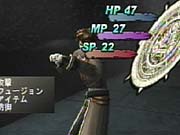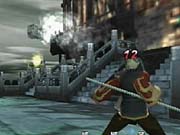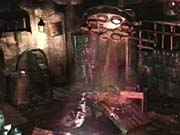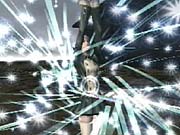Shadow Hearts Preview
Shadow Hearts is the first PlayStation 2 title published by Aruze, who's taking a stab at the non-pachinko-related gaming market. With the help of developer Sacnoth, which previously worked on such titles as Koudelka and a number of Neo Geo Pocket games, the publisher's first role-playing title was recently released in Japan. Today, we bring you an in-depth look at the game's unique systems, as well as our impressions of the final Japanese version.

The game takes place during the early 20th century. The story starts with a young girl named Alice Eliot--the daughter of an expert exorcist--being transported by the Japanese imperial army to China on a train. A powerful magician by the name of Roger Bacon is on the same train in attempt to kidnap her. Roger believes Alice is the key to his master plan to unlock ancient secrets that'll destroy the earth. Enter Urm Hyuga, the son of a Japanese soldier who died in battle 15 years ago. The young man is a harmonixer--a man with the ability to morph into different creatures. Guided by a mysterious female voice, he rescues Alice, foiling the kidnapping attempt. This is merely an introduction, though. Players will eventually journey all the way through China and into Europe, and they'll uncover the evil scheme of Roger and his minions, as well as unravel the mysteries surrounding the different characters. Later on, you will meet other playable characters: Syushin, an old Chinese mage who was close friends with Urm's father; Margaretta Zelle, an international spy for hire; Keith Valentine, a vampire; and Harry, a young boy who leads a group of orphans. The story is divided into two parts: Asia and Europe. The first half takes off interestingly as you travel through different cities in China, pursued by both Roger and the Japanese imperial army. There are factions in the imperial army conspiring against one another, and you are positioned right in the middle of it. By the time the story shifts its focus to Europe, the events of the first half unfortunately fade away, and the focus shifts to the second half, whose events take a whole different direction. Those who've played Koudelka might find it more interesting, and although we're not going to delve into the details, you can expect a lot of references to and guest appearances from that game.

So if Shadow Hearts is considered a pseudo-sequel to Koudelka--which was not an exceptionally great role-playing title--could this game be any different? The game does have several unique systems that add an interesting twist. Like any orthodox Final Fantasy-style RPG, the battle system is turn-based, driven by a set of commands. After you have performed an action, such as attacking, casting spells, or using an item, a "judgment ring" appears. This is a wheel that has shaded areas on its spokes and rotates at a constant speed. Depending on where the wheel stops spinning, certain outcomes will transpire. To be successful, you'll have to press a button to stop the wheel within the desired shaded areas. This system keeps you alert during combat and forces you to rely more on your hand-eye coordination. The judgment ring also appears in certain situations outside of battle. It'll make an appearance when you're trying to unlock a door, for example, and it'll appear in a shop, where it'll grant you a 20 percent discount if its results are favorable. You can even use it to acquire rare weapons through raffle draws. The speed of rotation and the shaded areas depend on the situation, the weapon used, or how powerful the attack or magic spell is. During battle, you can slow the speed or even widen the shaded areas using special items. You can also pay a blacksmith to make your weapons more powerful, which affects the ring favorably, or alter the shaded areas outright.

Another interesting mechanic in Shadow Hearts is the malice system, which integrates well into the story as well as the game system. As Urm defeats monsters, he gains soul points. Each monster falls into one of six elemental categories: light, darkness, fire, water, wind, or earth. The soul points are used by Urm to acquire new creatures to morph into. Each creature has a designated element. These new creatures can be acquired by visiting a place called the graveyard. But these soul points influence another factor--a pendant that Urm wears. The pendant in question changes color as he defeats more monsters. Early on in the game, you should frequently visit the graveyard to "purify" the pendant by fighting against ghosts. If you don't, the pendant will eventually turn red, and the next enemy you fight will either be a powerful being called the God of Death or one of the Four Masks of Evil--none of which should be fought against until you've progressed relatively far into the game.

Lastly, each character has what are called sanity points (SP) in addition to the standard hit points (HP) and magic points (MP). Each turn, the character loses one SP. Urm also consumes a certain amount of SP when he morphs into different creatures. In other cases, some powerful enemies can cast magic spells that take a chunk of your SP. When a character runs out of SP, that character goes "insane" and can no longer be controlled during combat-- he or she will attack anyone on the battlefield. Characters such as Alice who are not fit for combat have only a small amount of SP. Needless to say, if you are anticipating a long battle, carry some SP healing potions with you.
While these unique game systems will keep you glued to the game for the first few hours, you might feel less challenged toward the end of the game. The judgment ring only takes getting use to, even if the different weapons and magic spells change its characteristics slightly. The story and characters do generate interest, but toward the latter half of the game, players who missed Koudelka may not appreciate it as much. The dialogues vary--some are witty and humorous, while others are mediocre. The prerendered 2D backgrounds can be described as high-resolution versions of PlayStation backgrounds, while the 3D polygon models of the characters and enemy creatures are within the standards for a PlayStation 2 title. The effects for spells and when Urm morphs into different creatures are definite eye candy, but some of the sound effects don't convey things quite so effectively--the blasts from a shotgun, for example, sound more like shots coming from a pellet gun--and the musical compositions are a mixed bag. The talents of Sacnoth in the CG movie department were well used in Koudelka, but the Shadow Hearts cutscenes fall short of that standard in terms of both quality and quantity. Most of Shadow Hearts' cutscenes make use of sketched artwork and live action, rather than relying solely on CG movies. Shadow Hearts definitely brings new ideas into the role-playing genre, but in spite of that, it is a very average game. The game is currently available in Japan, but North American and European releases have not been announced to date.
Got a news tip or want to contact us directly? Email news@gamespot.com
Join the conversation